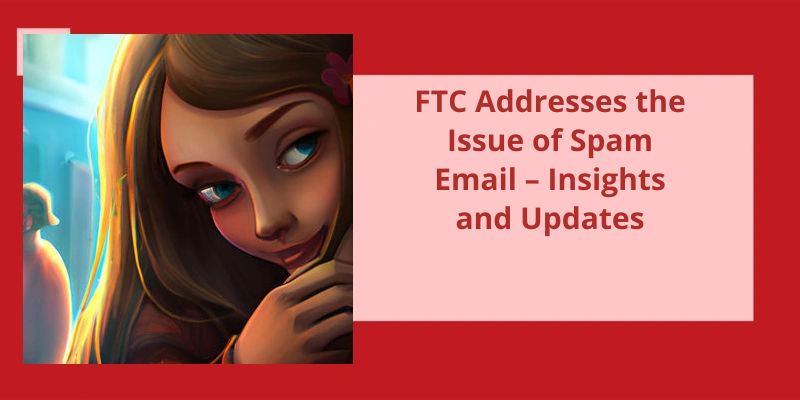Spam emails are a common problem in today's digital age, often cluttering inboxes and causing frustration for users. However, some spam emails go beyond annoyance and can be deceptive or even harmful. To combat this issue, the Federal Trade Commission (FTC) has established a system for reporting suspicious or deceptive spam emails. By forwarding these emails to ReportFraud.ftc.gov, users can contribute to the FTC's efforts to pursue legal action against those who send misleading or fraudulent emails. Through this database, the FTC is able to gather valuable information on spam trends and patterns, making it a key tool in the fight against email scams.
What Is the FTC Email Address for Spam?
With the rise of technology and the widespread use of the internet, the problem of spam and phishing emails has become a major concern for many. The Federal Trade Commission, also known as the FTC, has taken various measures to address this issue and protect consumers from fraud and scams.
One of the ways the FTC encourages consumers to report spam and phishing emails is by providing an easily accessible email address for them to do so. By forwarding suspicious emails to the Anti-Phishing Working Group at [email protected], consumers can help prevent further instances of fraud and protect themselves and others from cybercrime.
In addition to reporting phishing emails, consumers should also report phishing text messages by forwarding them to the number SPAM (7726). This allows the FTC and other organizations to track the source of the messages and take legal action if necessary.
It’s important to note that reporting phishing attempts to the FTC is crucial in not only preventing future fraud but also in helping in ongoing investigations. When consumers report fraud through the FTC’s online reporting system at ReportFraud.ftc.gov, they provide valuable information that can help authorities identify and take legal action against scammers.
Overall, reporting spam and phishing emails and texts can make a significant difference in protecting oneself and others from cybercrime. By working together, we can make the internet a safer place for everyone.
What Are Some of the Most Common Types of Email Scams?
- Phishing scams
- Spoofing scams
- CEO fraud scams
- Wire transfer scams
- Malware scams
- Advance fee scams
- Lottery scams
- Work-from-home scams
- Charity scams
- Romance scams
If you’re tired of receiving an overwhelming amount of unwanted emails, don’t fret. There are steps you can take to report and prevent spam emails from cluttering your inbox. One effective way is to report the spam to your email provider or the sender’s email provider. Read on to find out more.
Who Do I Contact About Unwanted Emails?
If you’re receiving unwanted emails, you may wonder who to contact to put a stop to them. In general, the first step is to report the spam to your email provider. Providers like Gmail, Hotmail, and Yahoo typically offer easy-to-use buttons to mark messages as junk mail or report spam. Doing so will help your provider learn which messages are unwanted and prevent them from appearing in your inbox in the future.
In some cases, you may receive unwanted emails from a company or organization that’s obtained your email address through legitimate means, such as from an online purchase or sign-up for a newsletter. In these cases, you should use the “unsubscribe” link included in the email to request to be removed from the senders mailing list. This is the easiest way to stop receiving unwanted emails from legitimate sources.
If you continue to receive unwanted emails after taking these steps, consider using email filters to automatically divert messages from specific senders or containing certain keywords into a separate folder or directly into your trash. You can also set your email client to block messages from specific senders or domains. These measures can help reduce the amount of unwanted email you receive and help restore some of your peace of mind.
Remember, reporting unwanted emails and spam isn’t only important for your own peace of mind, but also helps prevent the spread of spam and other malicious messages across the internet. By taking action to prevent unwanted emails, you’re doing your part to keep the online ecosystem healthy and safe for everyone.
How to Recognize Phishing Emails and What to Do if You Receive One.
- Check the sender’s email address carefully. Phishing emails sometimes use email addresses that look very similar to the real one, but have a small difference to trick you.
- Hover your mouse over a link in the email to see the actual URL without clicking on it. If the link looks suspicious, don’t click on it.
- Watch out for urgent or threatening language in the email that attempts to make you act quickly without thinking.
- Be cautious of emails that ask for sensitive information like usernames, passwords, credit card numbers, or social security numbers. Legitimate companies typically don’t ask for this information via email.
- If you receive a suspected phishing email, don’t respond to it or click on any links. Instead, forward the email to your email provider or the company being impersonated.
- If you accidentally clicked on a link in a phishing email and provided sensitive information, contact your bank or credit card company immediately.
If you come across spam emails, it’s important to report them as they can be harmful in various ways, such as stealing your personal information or installing malware on your device. One of the places you can report them is to the Federal Trade Commission (FTC). By reporting these emails to FTC, you’re helping to keep yourself and others safe from these fraudulent activities.
Where Do I Report Spam Emails?
If you’ve received spam emails, it’s important to report them to the appropriate organizations in order to help prevent others from falling victim to similar scams. One option is to report the spam to your email provider, who may be able to take action to block the sender or prevent similar messages from being sent in the future. You can typically find instructions for reporting spam within your email account settings or by contacting customer support.
Another option is to report the spam to the Federal Trade Commission (FTC) at ReportFraud.ftc.gov. The FTC is a government agency that works to protect consumers from fraudulent activity, including spam emails. Reporting spam to the FTC can help them identify trends and patterns of spam activity, which may lead to crackdowns on spammers and help protect others from similar scams.
When reporting spam to the FTC, it’s important to include as much information as possible about the email, such as the subject line, senders email address, and any relevant links or attachments. You may also be asked to provide information about any losses or damages you suffered as a result of the spam, such as financial losses or identity theft.
In addition to reporting the spam to your email provider and the FTC, you can also take steps to protect yourself from future spam emails. This may include setting up spam filters within your email account, being cautious about providing your email address to unknown parties, and avoiding clicking on links or downloading attachments from suspicious emails.
Source: How To Get Less Spam in Your Email | Consumer Advice
It’s important to know how to report fraudulent activity and seek help from authorities. One common question individuals may have is whether the FTC resolves individual complaints. The answer is no; however, the FTC takes reports seriously as they can help law enforcement recognize patterns of illegal activity, which may lead to investigations. In this article, we’ll go over the steps to report fraud to the FTC and what happens after you make your report.
Does the FTC Resolve Individual Complaints?
The Federal Trade Commission, or FTC, is a government agency tasked with protecting consumers and promoting competition in the marketplace. While the FTC doesn’t directly resolve individual complaints, it relies heavily on consumer reports to detect patterns of fraudulent or deceptive behavior. Complaints filed with the FTC help identify potential violations of the law and may lead to investigations and enforcement actions.
To report a potential fraud or scam, consumers can file a complaint with the FTC through it’s online portal at ReportFraud.ftc.gov. The online form gathers information about the nature of the complaint, including details about the company or individual involved, the type of scam or fraud, and any financial losses incurred. Consumers can also provide supporting documents, such as copies of emails, receipts, or other evidence.
Once a complaint is filed with the FTC, it’s reviewed by analysts who evaluate the information provided and determine whether further investigation is warranted. The FTC investigates cases that have the potential to harm a large number of consumers or involve significant financial losses. Depending on the severity of the issue, the FTC may work with other law enforcement agencies to pursue legal action, seek restitution for victims, or obtain injunctions to stop ongoing fraudulent activity.
It’s important to note that while the FTC doesn’t directly resolve individual complaints, filing a report can have a positive impact on the overall enforcement of consumer protection laws. By collecting data on various scams and fraudulent schemes, the agency is better equipped to take broader action to protect consumers and prevent similar scams from happening in the future.
In addition to reporting fraud to the FTC, consumers can also take steps to protect themselves from scams and fraudsters. This includes being cautious when sharing personal information online or over the phone, staying informed about the latest scam tactics, and being skeptical of any unsolicited offers or requests for money or personal information.
It can be frustrating to suddenly receive an influx of spam emails in your inbox. However, this is a common occurrence when scammers purchase bulk email addresses from particular providers. If your address is part of one of these lists, you may continue to receive unwanted emails unless you take steps to protect yourself.
Why Am I Suddenly Receiving Lots of Spam Emails?
There are several reasons why spammers target email addresses. One common reason is to promote a product or service. Spammers may send out emails promoting fake products, offering discounted services, or trying to entice you to sign up for a subscription. Other times, spammers may try to gain access to your personal information. They may send phishing emails that mimic legitimate organizations in an attempt to get you to provide your login credentials or other sensitive data.
Another reason why you may be getting a lot of spam emails could be due to malware or viruses on your computer. If you’ve a virus or malware on your machine, it may be sending out spam emails without your knowledge. It’s important to regularly update your anti-virus software to protect against such threats. Additionally, be careful when clicking on links or downloading attachments from unknown sources.
Email harvesters are also commonly used by spammers to collect valid email addresses. These are computer programs designed to crawl the internet and collect email addresses found on websites, forums, and public documents.
Finally, it’s possible that you may have unknowingly signed up for a mailing list or newsletter that’s now sending you unwanted spam emails. Be sure to check your spam folder regularly and mark any unwanted emails as spam to prevent them from landing in your inbox. If you no longer wish to receive emails from a particular sender, be sure to unsubscribe from their mailing list.
To protect yourself from these threats, be sure to regularly update your anti-virus software, be careful when clicking on links or downloading attachments, and mark any unwanted emails as spam.
How to Spot Phishing Emails and Protect Yourself From Identity Theft
- Check the sender’s email address and make sure it’s legitimate.
- Be wary of urgent or threatening language.
- Avoid clicking on links in unsolicited emails.
- Hover over links to see where they lead before clicking.
- Don’t enter personal information into suspicious websites or forms.
- Use anti-virus software to protect against malware.
- Keep your software and operating system up-to-date.
- Enable two-factor authentication for added security.
- Report any suspicious emails or activity to the appropriate authorities.
Conclusion
In a world where spam emails continue to plague individuals and businesses alike, it’s reassuring to know that there are measures in place to combat this issue. The Federal Trade Commission provides a valuable resource in the form of it’s spam reporting database, allowing individuals to report and track suspicious emails. By leveraging this tool, the FTC is able to pursue legal action against those who engage in deceptive email practices, ultimately helping to create a safer and more secure online environment. As such, it’s important for individuals to remain vigilant and report any suspicious emails they receive to further the fight against spam.






